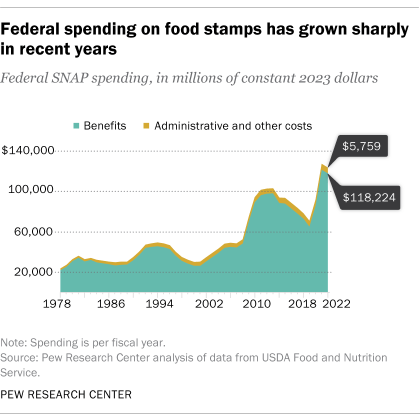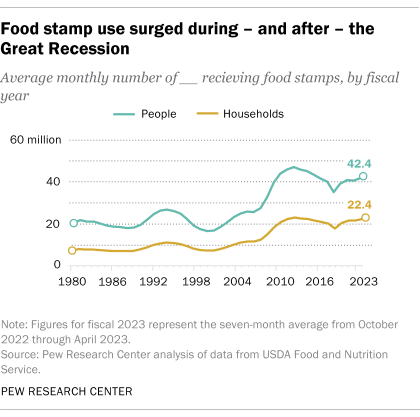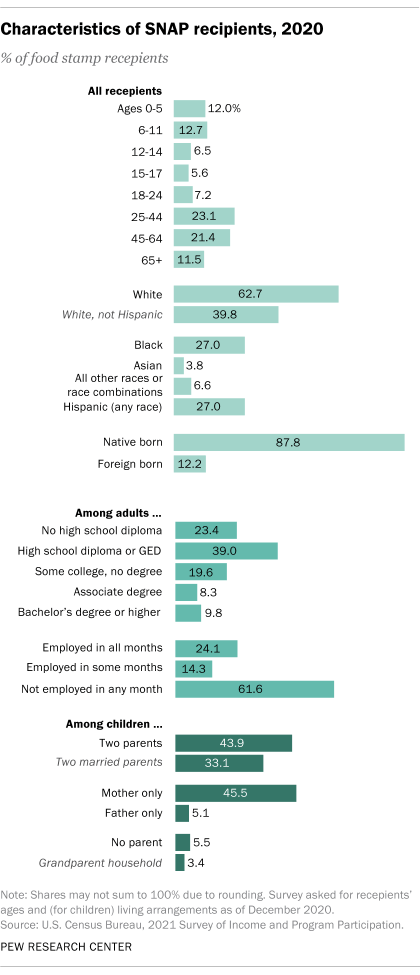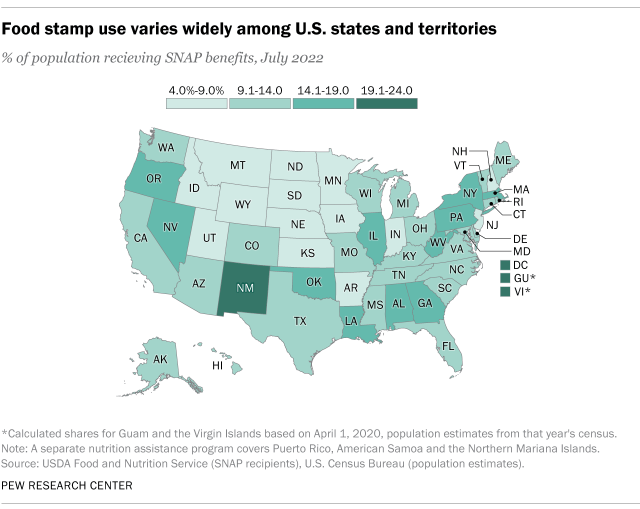One component of the recent deal to raise the federal debt limit and cut government spending is additional work requirements for certain people who receive benefits from the Supplemental Nutrition Assistance Program, or SNAP – commonly known as food stamps.

The food stamp program is one of the larger federal social welfare initiatives, and in its current form has been around for nearly six decades. But many misconceptions remain about the program and how it works. (For one thing, no actual stamps are involved.) Here’s a closer look at the food stamp program, based on data from the U.S. Department of Agriculture, the Census Bureau and other sources.
The Supplemental Nutritional Assistance Program (SNAP), also known as the food stamp program, is back in the news amid recent changes enacted as part of a debt ceiling deal between President Joe Biden and House Republicans. With that in mind, we thought it was time to take an in-depth look at the program.
Our main data source was the Food and Nutrition Service, the agency of the U.S. Department of Agriculture that administers SNAP and other food assistance programs. We supplemented the FNS data with data from the Census Bureau’s Survey of Income and Program Participation, which focuses on the demographic and other characteristics of people and households who receive various forms of federal assistance. We also used the Census Bureau’s population and household estimates in some of our analyses. Finally, we obtained government expenditure data for other federal assistance programs from the Office of Management and Budget.
How many Americans use food stamps?
The numbers vary from month to month. But in April 2023, the most recent month with available figures, 41.9 million people in 22.2 million households received SNAP benefits. That translates to 12.5% of the total U.S. population.
On average, 41.2 million people in 21.6 million households received monthly SNAP benefits in the 2022 fiscal year, which ran from October 2021 through September 2022.
The program operates in all 50 states, the District of Columbia, Guam and the Virgin Islands. A separate nutrition assistance program covers Puerto Rico, American Samoa and the Northern Mariana Islands.
How has the number of food stamp recipients changed over time?
The current food stamp program began in 1964 but took several years to ramp up. It wasn’t until July 1974 that states – which share administrative duties over the program with the federal government – were required to extend it to all jurisdictions within their borders. That year, 12.9 million people, or 6.0% of the total U.S. population at the time, received SNAP benefits.

Total participation has ebbed and flowed over the ensuing decades, driven both by economic conditions and changes in eligibility rules. Between fiscal years 1980 and 2008, the share of all U.S. households receiving SNAP benefits oscillated between about 7% and about 11%. But that percentage rose rapidly during the Great Recession and peaked at 18.8% in fiscal 2013 – representing 23.1 million households, or 47.6 million people.
In March 2020, as the nation headed into COVID-19 lockdowns, Congress authorized extra SNAP benefits for recipients and suspended work and training requirements for the duration of the declared public health emergency. The number of recipients immediately jumped from 37.2 million in March 2020 to 40.9 million one month later, and topped out in September 2020 at just over 43 million recipients, or 13% of the resident population.
Who is eligible for food stamps?
In general, a household qualifies for the program if it has a gross monthly income at or below 130% of the federal poverty level as well as a net monthly income at or below 100% of the federal poverty level. For a family of four in 2023, this works out to $3,007 in gross monthly income and $2,313 in net monthly income. (These limits are higher in Alaska and Hawaii.)
Households with older people (defined as ages 60 and older) or people with disabilities only have to meet the net income requirement. And households of all types are limited in how much they can have in cash, investments and other assets and still qualify for SNAP.
In addition, households receiving other types of aid, such as Temporary Assistance for Needy Families (TANF) or Supplemental Security Income (SSI), may be eligible for SNAP automatically.
States have a certain amount of latitude in how they administer the SNAP program. For example, they can decide how broadly to extend its benefits to people receiving other TANF-funded benefits, whether to count vehicles as household assets, and whether to count child support payments as income. In addition, there are somewhat different eligibility rules for Alaska, Hawaii, Guam and the Virgin Islands.
What, if any, work requirements are there for receiving food stamps?
In general, most Americans ages 16 to 59 who aren’t disabled must register with their state SNAP agency or employment office; meet any work, job search or job training requirements set by their state; accept a suitable job if one is offered to them; and work at least 30 hours a week. Failure to comply with those rules can disqualify people from getting SNAP benefits.
In addition, nondisabled adults without dependents must either work or participate in a work program for 80 hours a month, or participate in a state workfare program. If they fail to do so, they can only receive SNAP benefits for three months out of any 36-month period. Until recently, this additional work requirement applied to people ages 18 to 49. The debt limit deal recently enacted raises the maximum age to 54, a change that will be phased in over three years starting in October. The new law also exempts veterans, homeless people and young adults aging out of foster care from all work requirements.
What do we know about food stamp recipients in the U.S.?

The most comprehensive data source we have is the Census Bureau’s Survey of Income and Program Participation, although its most recent data is from 2020. That year, 23.6 million SNAP recipients (63%) were adults, and 13.8 million (36%) were children.
Non-Hispanic White people accounted for 44.6% of adult SNAP recipients and 31.5% of child recipients in 2020. About 27% of both adult and child recipients were Black. Hispanic people, who can be of any race, accounted for 21.9% of adult recipients and 35.8% of child recipients.
The vast majority of both adult and child recipients were born in the United States – 82.3% and 97.1%, respectively.
Among adult recipients, 62.4% had a high school diploma or less education in 2020. And despite the program’s work requirements, 61.6% said they had not been employed at all that year.
The Census Bureau also looked at households where at least one person received SNAP benefits. More than six-in-ten of these households (61.7%) reported having no children in 2020, including 34.4% who were people living alone. More than 40% of SNAP-receiving households were in the South, the highest percentage of any region.
How much do food stamp recipients get each month?
In April 2023, the national average benefit was $181.72 per person and $343.00 per household. That was a sharp drop from February’s averages ($245.44 per person, $464.36 per household), reflecting the expiration of the extra benefits put in place during the pandemic.
The nationwide averages conceal a considerable amount of state-by-state variation. SNAP beneficiaries in New York received an average of $212.09 per person in April 2023, while recipients in Oklahoma got $127.32. (These rankings exclude Alaska, Hawaii, the Virgin Islands and Guam, which have a different scale to reflect higher food costs in those places.)
Why do benefits vary so much by state? One reason is that benefit amounts are largely determined by recipients’ income, minus certain expenses. Household size also factors into the calculation. So a state’s demographics and the condition of its economy will influence how much its residents can receive through SNAP.
The maximum amount of SNAP benefits is based on the Thrifty Food Plan, an estimate by the U.S. Department of Agriculture of how much it costs to buy groceries needed to provide a “nutritious, practical, cost-effective diet” for a family of two adults and two children. That amount is adjusted for other household types when determining benefit levels. The Thrifty Food Plan was updated in 2021 for the first time in 15 years and is scheduled to be re-evaluated again in 2026.
Which states have the highest and lowest rates of food stamp usage?
In New Mexico, 22.9% of the population receives SNAP benefits – the highest of any state, according to a Pew Research Center analysis of SNAP recipient figures and Census Bureau population estimates for July 2022, the most recent available. The District of Columbia is next-highest at 21.4%, followed by Oregon at 17.8% and West Virginia at 17.7%. (We excluded the Virgin Islands and Guam from this analysis because the Census Bureau doesn’t have 2022 population estimates for them. But using 2020 census counts instead would give them rates of 23.8% and 23.6%, respectively.)
Utah has the nation’s lowest rate of SNAP use: Just 4.6% of Beehive State residents get the benefits, according to our analysis. Other states with low rates include New Hampshire (5.0%), Wyoming (5.1%) and North Dakota (5.8%).

What can you buy with food stamps? What can’t you buy?
SNAP benefits can be used to buy most groceries for household use, including breads and pastries; meats, poultry and fish (but not, in most cases, live animals and birds); fruits and vegetables; dairy products, including ice cream; and snack foods such as cookies, cakes and soft drinks. Recipients can also use SNAP benefits to buy plants and seeds to grow food for the household, but not (for example) non-edible flowers.
Alcoholic beverages and tobacco products cannot be bought with SNAP benefits, nor can nutritional supplements, medicines or pet food. Foods that are sold hot (think rotisserie chickens or ready-to-eat soups) aren’t eligible either, nor are household goods such as paper towels, cleaning products and toiletries. Gasoline isn’t eligible either.
Where can people use food stamps? Where do they use them most frequently?
More than 254,000 establishments accepted SNAP benefits in fiscal year 2021, but two types stand out: Supermarkets and “superstores” such as Walmart and Target together make up about 15% of SNAP-accepting establishments, but they accounted for nearly 80% of all redemptions.
By comparison, more than 44% of all SNAP-accepting establishments are convenience stores, but they accounted for only about 5% of redemptions in 2021. Notably, while only 89 internet retailers, such as Amazon, were authorized to accept SNAP benefits that year, they accounted for nearly 4% of redemptions.
How much does the federal government spend on food stamps each year?
In fiscal 2022, the government spent $119.4 billion on SNAP. Some $113.9 billion went to benefits while $5.5 billion went to administrative and other expenses. Through the first seven months of fiscal 2023 – that is, October 2022 through April 2023 – the government spent almost $70 billion on benefits alone, 2.8% more than during the corresponding period in fiscal 2022.
SNAP is one of the largest federal social welfare programs in terms of cost. For comparison, in fiscal 2022, the federal government spent $747.2 billion on Medicare, $591.9 billion on Medicaid, $161.2 billion on veterans’ benefits, $58.8 billion on Supplemental Security Income and $33.1 billion on unemployment compensation.
How has the cost of the food stamp program changed over time?
SNAP is an entitlement program, which means spending on it rises and falls based primarily on how many people qualify for benefits (but also through changes in its authorizing legislation). Adjusted for inflation, annual spending on SNAP followed a regular pattern from the late 1970s to 2008: It fell to around $30 billion a year during strong economic times and rose during and immediately after recessions – at times reaching $50 billion.
The Great Recession changed that pattern, perhaps permanently. Spending on SNAP jumped as the economy sank, but it kept rising even as the “recovery” began, topping out at about $103 billion in inflation-adjusted dollars in fiscal 2013. Spending on the program then fell slowly, until the COVID-19 pandemic upended the U.S. economy. SNAP spending soared from $91.8 billion in fiscal 2020 to $127.6 billion in fiscal 2021, and fell back only slightly last year.
Why are they called “food stamps,” anyway?
The precursor to the modern SNAP program, which began in 1939 and ran until 1943, did use actual stamps. Besides feeding the hungry, the program was designed to aid farmers struggling with surplus crops they couldn’t sell profitably.
People receiving public assistance could buy orange stamps that were exchangeable, dollar for dollar, for most food items at grocery stores. For every dollar participants spent on orange stamps, they also received 50 cents’ worth of blue stamps, which could be spent only on USDA-designated surplus commodities such as beans, eggs, dairy products, fruits and vegetables. Over the program’s lifespan, approximately 20 million people received food stamps at one time or another, at a total cost of $262 million.
The U.S. entry into World War II put an end to the first food stamp program, as the war effort absorbed both farm and labor surpluses. But the concept stuck in people’s heads, and when it was revived in 1964 as part of President Lyndon Johnson’s “War on Poverty,” it was formally named the Food Stamp Program. But instead of stamps, beneficiaries purchased multicolored “food coupons” that could be used much like cash. The purchase requirement was eliminated in 1977, benefits began to be widely delivered by debit card in the 1990s, and by 2004 the paper coupons had gone the way of the blue and orange stamps. The program was renamed SNAP in 2008.
